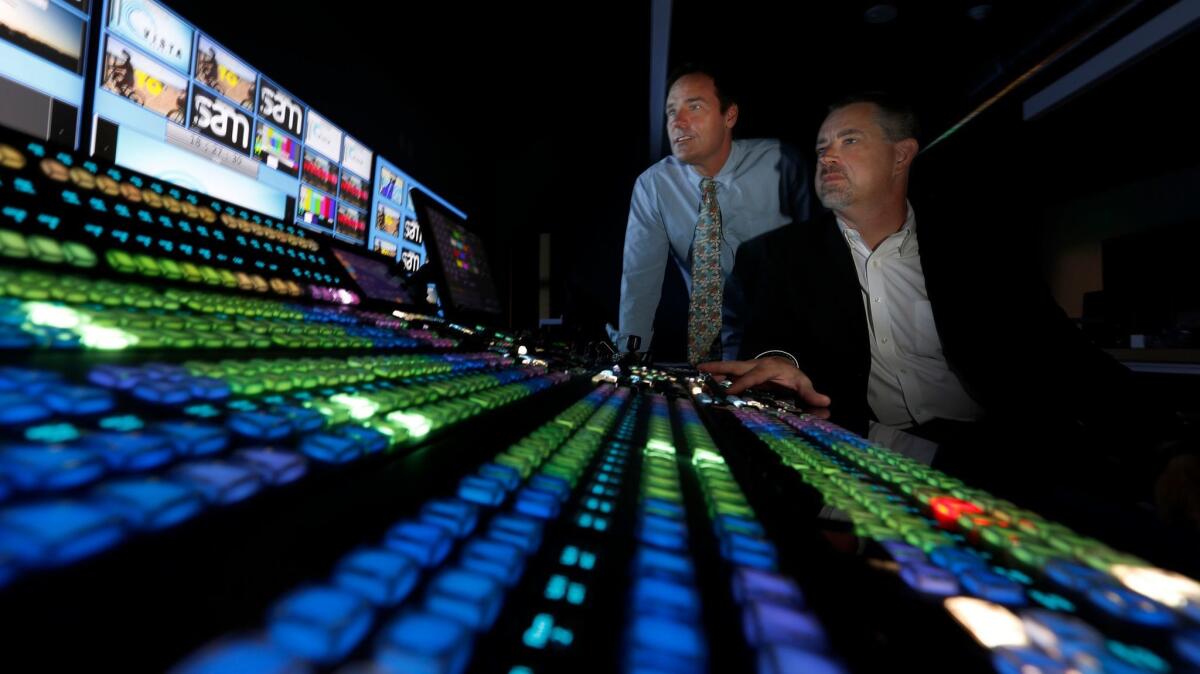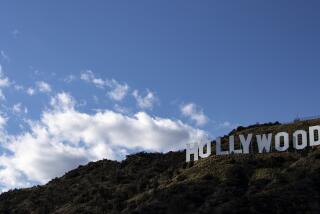TV production is soaring in L.A. But that means more competition for soundstages

- Share via
The golden age of television has brought production roaring back to the Los Angeles area, with streaming companies and cable channels shooting year-round to fill viewers’ insatiable demand. But producers are facing an unintended consequence of the surge in local shoots — a shortage of soundstage space.
From Hollywood’s famed backlots to the stages that dot the Santa Clarita Valley, local facilities are having trouble keeping up with the bounty of TV production, with occupancy levels at some studios reaching new highs.
Industry insiders said the crunch is the result of a convergence of factors. Not only are producers bringing shows back to L.A. to take advantage of California’s expanded tax incentives, they also are facing unprecedented competition for space from streaming companies like Netflix and Amazon, as well as new-media outlets such as Buzzfeed, which are ramping up production of original shows and signing long-term leases at local facilities.
Further contributing to the shortage is the lack of new studio construction. As the value of land continues to rise in L.A., developers see acreage-hogging soundstages as a poor investment.
Many studios in the L.A. area are legacy facilities, some dating back to the silent film era. As a result, the number of new lots isn’t keeping up with the rise in demand.
“Soundstages have historically run at a utilization rate of about 70%. Today, many are running at close to 100%,” said Carl Muhlstein, international director at the commercial real estate firm JLL, where he works with many L.A. production facilities.
“For the first time in a long time, tenants like Netflix are signing long-term, 10-year leases,” Muhlstein said. “This is unusual because they usually did it on a production-by-production basis.”
A more crowded market means that renters can expect to pay more. For example, at L.A. Center Studios, where the acclaimed AMC series “Mad Men” was filmed, rents have increased 3% annually in the last three years after nearly a decade of being flat.
“Soundstage users have less clout in negotiating,” Muhlstein said.
Last year, Netflix signed a 10-year lease at Sunset Bronson Studios, one of three studio facilities owned by the L.A.-based Hudson Pacific Properties, the largest independent owner of stages in Hollywood. The streaming giant also leases the adjacent office tower that recently opened and serves as its L.A. headquarters.
Long-term studio leases are likely to become more common in the future, said Bill Humphrey, senior vice president at Hudson Pacific, who oversees its Hollywood studio facilities.
“People need to lock down their needs of production,” Humphrey said. “Netflix and Amazon don’t own stages. And they don’t necessarily want to own stages.”
He said utilization at Hudson Pacific’s three Hollywood lots — including Sunset Gower and the recently acquired Sunset Las Palmas — is in the 90% range, a historic high for the properties. In addition to streaming companies, the stages host spillover productions from nearby facilities like CBS Studios.
In a sign of rising demand, Hudson Pacific last month acquired Sunset Las Palmas — formerly known as Hollywood Center Studios — for $200 million. The historic lot was the former home of United Artists, where Mae West, the Marx Brothers and Cary Grant made pictures.
“There’s competition for the stages,” Humphrey said. “It’s not dissimilar to the housing market, where seven people might want one property.”
The scarcity is exacerbated by the slow pace at which the major Hollywood studios — including Walt Disney Co. and Paramount — are expanding their own backlot facilities. The studios often face arduous approval processes that include environmental and traffic-impact studies.
Disney revealed plans in 2009 for a new production facility for ABC Studios at its Golden Oak ranch near Santa Clarita and received county approval four years later. But the project remains in limbo, with groundbreaking delayed and no completion date in sight. Disney did not respond to a request for comment.
Paramount received L.A. city approval in October to expand its historic Melrose Avenue lot. But the massive project, which comes with a $700-million price tag, will be slow in relieving congestion as construction rolls out over 25 years.
Experts say regulatory red tape and costs motivate many Hollywood studios to lease off-site soundstages.
The bottleneck in demand is due in part to California’s expanded tax incentive program, which began in July 2015 and is set to run for five years. The incentives are designed to reverse the flight of productions from California to states such as Georgia and Louisiana, which offer lucrative financial enticements to filmmakers.
The California film and TV tax credit program tripled funding to $330 million annually, the majority of which goes to TV production.
The state’s tax breaks have lured popular series, including Fox’s “Lucifer,” FX’s “Legion” and Netflix’s “The OA.” Other shows that have relocated from other states include HBO’s “Veep” and “Ballers.”
On-location production shoots in the L.A. area rose 6.2% in 2016 from the previous year, with TV comprising the biggest portion of productions, according to data from FilmL.A., the nonprofit group that oversees film permits in the city and county. The data only represent location filming on streets, not on certified soundstages.
“Once the incentives were announced, demand definitely picked up,” said Sam Nicassio, president of L.A. Center Studios, which operates six soundstages. Recent streaming tenants include the Amazon series “Hand of God” and the Netflix movie “Bright.”
Nicassio said L.A. Center Studios stages are running at 100% capacity.
Valencia Studios has been equally busy. All six of its stages are devoted to the long-running CBS series “NCIS.” Owners are planning to open a new lot in Chatsworth this year called Crimson Studios, which will reside in a converted complex and double the company’s size.
“We think there is a demand,” said Richard Reilly, co-owner of Valencia Studios. “The tax credits are a significant factor in terms of where people want to shoot.… I think people would much rather shoot here than travel and live out of temporary housing.”
The founders of Vista Studios, which recently opened in Playa Vista, are also hoping to capitalize on rising demand. The facility consists of four stages geared for multi-camera TV production and live broadcasting.
“There was an unfulfilled need,” said co-founder Randall Heer, adding that the vast majority of local soundstages are located east of the 405 Freeway.
Much of the need for space comes from short-form online videos produced by new media outlets such as Buzzfeed and the Disney-owned Maker Studios. They are pumping out content to satiate the millennial generation’s bottomless appetite for short clips they can watch on mobile devices.
In 2016, on-location production for online videos in L.A. rose 46% from the previous year, a larger percentage gain than TV and film production, according to FilmL.A.
Buzzfeed is one of the biggest local producers of online videos and currently leases all of Siren Studios’ facilities on Sunset Boulevard.
“More content is being created, and that has created more demand for our spaces,” said Dean Gavoni, CEO at Siren Studios.
Local movie production hasn’t rebounded to the same degree as TV. Georgia still outranks California in terms of attracting major films, thanks to more generous incentives, according to a recent report from FilmL.A.
But L.A. has attracted a handful of major movies. Warner Bros.’ “A Star Is Born,” starring Lady Gaga and Bradley Cooper, has been shooting throughout Southern California in recent days. Amazon Studios’ drama “Beautiful Boy,” starring Steve Carrell, has also been filming in L.A.
ALSO
Despite Trump stumbles, optimism of top U.S. CEOs hits highest level in three years
20th Century Fox expands gaming portfolio by acquiring Aftershock
NBC’s ‘Sunday Night With Megyn Kelly’ premiere with Putin pulls in 6.1 million viewers
More to Read
Inside the business of entertainment
The Wide Shot brings you news, analysis and insights on everything from streaming wars to production — and what it all means for the future.
You may occasionally receive promotional content from the Los Angeles Times.











